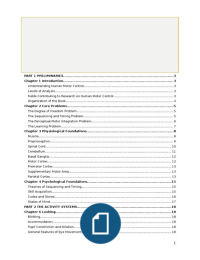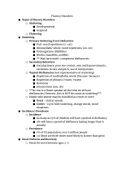Complete Summary 2.5C Global Development Issues
Textbook: Szirmai, Adam (2015). Socio-Economic Development, 2nd edition. Mandatory
chapters: 1,2,3,11,12, 13 and 14.
Lecture 1 - Introduction to global development and its history
- Szirmai (2015) chapter 1 & 13
- Haslam et al (2017)
- TedTalk Joseph Gaskins Jr
1 - Conceptualizing development
Labeling international development (Haslam et al, 2017)
- Old labels: these labels are often too encompassing to be explanatory. Every
country has a different context.
- Developed vs underdeveloped countries
- The Third World ( → Third Worldism: Western countries have a duty to
support these countries in their development. This ideology was highly
influenced by NGOs)
- Non-aligned movement
- Labels by international institutions:
- Developing countries: notion of potential
- World Bank’s categories
- Least developed countries (UN)
- George Manuel (1921-1989):
- “The Fourth World”
- Global South: countries having an origin in colonization.
- Movement towards decolonization of development studies: ownership &
sovereignty of nations
- In this course we are using the following terminology: developing countries and
Global South
Common features of developing countries (Szirmai, 2015)
- Widespread poverty and malnutrition
- Relatively large share of agriculture in output and employment
- Pronounced dualism in economic structure ( → inequality)
- Rapid growth of population
- Explosive urbanization
- Large-scale under-utilization of labor
- Political instability
- Weak governance, pervasive corruption
- Environmental degradation
- Low levels of technological capabilities
Conceptualizing development
- “The process in which someone or something grows or changes and becomes
more advanced” (Cambridge English Dictionary definition)
- Poverty vs. prosperity
- Multi-faceted & intergenerational concept
, - A good development strategy entails:
- There is a need for material resources
- There is a need for growth (up to a limit)
- Inclusion: reducing poverty, reducing inequality
- Structural transformation: social welfare, progress
- Freedom and capabilities
- Sustainability: caring for the future generation
2 - Measuring development: different indicators that can be used to measure
development
Income and development
- Gross National Income (GDP): sum of all incomes in a country
- Minus income transfer to abroad
- Plus income transfers from abroad (e.g.: remittances)
- The GDP is highly sensitive to the size of a country and its population
- GDP per capita: average income,
- But: what about inequality? GNI/GDP per capita does not reflect how equally
the income is divided ( → Gini-index)
- Level of income is necessary, but not a sufficient condition for development
- Issues with GNI:
- Does not capture the informal economy
- Does not take into account (positive/negative) externalities (e.g.: education,
health, pollution)
- Unit of analysis does not reflect the actual living standard in a country
- New unit of analysis: Purchasing Power Parity (PPP): how much can an individual
buy with 1$ in their country?
- Reflects living standards
- Reduction of income gap between countries
Growth and development
- Very sensitive to exogenous shocks (which is why the average is more reliable to
use than the annual change)
- Natural hazard
- Conflict
- Transnational crises (e.g.: Covid-19, Ukraine war)
- Catch-up effect: “poorer” economies are more likely to grow fast than “richer”
economies
- Growth is due to stagnate
- Growth measures a potential, not the actual development of a country →
dependent on implementation and execution of domestic policies
Poverty
- Absolute vs relative poverty
- Multi-dimensional phenomenon: towards a capabilities approach (Amartya Sen
discussed in Haslam et al, 2017)
, - Development should be evaluated according to the extent of freedom people
have to promote and achieve functions they value (poverty is thus a
deprivation of freedom) → Sen’s capabilities approach
- This approach underlines absolute deprivations, since all people need a
minimum amount of capabilities to function as fully human
- Human Development Index (HDI)
3 - Causes of growth, development and stagnation
Two theoretical approaches to development (Szirmai 1.1)
- Short-term:
- Focus on fight against widespread poverty, hunger
- Aim for rapid improvement of the situation
- Importance of policies
- Role of (relief) aid
- Can be victims of trends
- Long-term:
- Focus on the structural drivers of development
- Comparative approach
- Not necessarily Western-centered (Egger’s disagreement Szirmai?)
- What can we tell policy-makers?
- Both approaches are important and ideally are combined when creating development
strategies
Development: a primary domestic struggle
- Three drivers that interact and determine development:
- Political drivers
- Economic drivers
- Social drivers
- E.g.: migration, trade, international governments
Causes of development: a framework
- Ultimate causes: structural matters
- Geography
- Demography
- Political, economic and social institutions
- Intermediate causes:
- International and domestic trends
- Economic, social and technology policies
- Proximate causes: short-term matters
- Measurable economic determinants
- Output = Function of (Capital, Labour, Resources)^efficiency + net factor
income + Colonial impact
- O = F (K,L,R) ^ e + A + P
- Role of economic agents
- Aim: improvement of socio-economic outcomes
, 4 - The ultimate causes of development: the weight of history
Explaining the expansion and domination of Europe
- How did Europe become the center of growth and dominant power worldwide?
- In 1500, there were competing economic orders, that were at the time equal in
potential:
- European model
- Islamic model
- Chinese model
- How come that Europe prevailed? (Wallerstein)
- Decentralized political system vs imperial burden
- Crisis of feudalism benefitted different social classes (nobility, state, new
middle class) → converging interest
- Unified support to an expansionist project (Columbus) vs inward looking
Chinese empire
- They found gold → the influx of gold stimulated trade
The legacy of colonialism (TedTalk Joseph Gaskins Jr)
- Types of colonization:
- Colonies of settlement
- Pure colonies of settlement (USA)
- Mixed colonies of settlement (Mexico)
- Plantation colonies (Brazil)
- Colonies of occupation (Indonesia, India, Vietnam)
- Trading posts
- Factors that influence the type of colonization: settler mortality, military technology of
indigenous people
- Process of expansion and contraction of the European empire
Two perspectives on international development
- Formation and dynamization of the world economy (more optimist view)
- The European boom mattered
- Industrial revolutions and their diffusion
- Globalization and institutionalization of cooperation (Szirmai, ch 13)
- Served as an example
- But also a threat: triggered reaction and development
- Exploitation and increasing inequality in the emerging world economy (more
pessimist view)
- 1450: no strong differences in prosperity
- European boom coupled vs stagnation and exploitation
- Formation of world economy associated with explosive growth of global
income inequality
- International development is the result of colonial and neo-colonial practices
Big development questions…
- How can we explain growth in some regions of the world and stagnation in
others?
- Shall the Global South follow the example of the Global North?
Textbook: Szirmai, Adam (2015). Socio-Economic Development, 2nd edition. Mandatory
chapters: 1,2,3,11,12, 13 and 14.
Lecture 1 - Introduction to global development and its history
- Szirmai (2015) chapter 1 & 13
- Haslam et al (2017)
- TedTalk Joseph Gaskins Jr
1 - Conceptualizing development
Labeling international development (Haslam et al, 2017)
- Old labels: these labels are often too encompassing to be explanatory. Every
country has a different context.
- Developed vs underdeveloped countries
- The Third World ( → Third Worldism: Western countries have a duty to
support these countries in their development. This ideology was highly
influenced by NGOs)
- Non-aligned movement
- Labels by international institutions:
- Developing countries: notion of potential
- World Bank’s categories
- Least developed countries (UN)
- George Manuel (1921-1989):
- “The Fourth World”
- Global South: countries having an origin in colonization.
- Movement towards decolonization of development studies: ownership &
sovereignty of nations
- In this course we are using the following terminology: developing countries and
Global South
Common features of developing countries (Szirmai, 2015)
- Widespread poverty and malnutrition
- Relatively large share of agriculture in output and employment
- Pronounced dualism in economic structure ( → inequality)
- Rapid growth of population
- Explosive urbanization
- Large-scale under-utilization of labor
- Political instability
- Weak governance, pervasive corruption
- Environmental degradation
- Low levels of technological capabilities
Conceptualizing development
- “The process in which someone or something grows or changes and becomes
more advanced” (Cambridge English Dictionary definition)
- Poverty vs. prosperity
- Multi-faceted & intergenerational concept
, - A good development strategy entails:
- There is a need for material resources
- There is a need for growth (up to a limit)
- Inclusion: reducing poverty, reducing inequality
- Structural transformation: social welfare, progress
- Freedom and capabilities
- Sustainability: caring for the future generation
2 - Measuring development: different indicators that can be used to measure
development
Income and development
- Gross National Income (GDP): sum of all incomes in a country
- Minus income transfer to abroad
- Plus income transfers from abroad (e.g.: remittances)
- The GDP is highly sensitive to the size of a country and its population
- GDP per capita: average income,
- But: what about inequality? GNI/GDP per capita does not reflect how equally
the income is divided ( → Gini-index)
- Level of income is necessary, but not a sufficient condition for development
- Issues with GNI:
- Does not capture the informal economy
- Does not take into account (positive/negative) externalities (e.g.: education,
health, pollution)
- Unit of analysis does not reflect the actual living standard in a country
- New unit of analysis: Purchasing Power Parity (PPP): how much can an individual
buy with 1$ in their country?
- Reflects living standards
- Reduction of income gap between countries
Growth and development
- Very sensitive to exogenous shocks (which is why the average is more reliable to
use than the annual change)
- Natural hazard
- Conflict
- Transnational crises (e.g.: Covid-19, Ukraine war)
- Catch-up effect: “poorer” economies are more likely to grow fast than “richer”
economies
- Growth is due to stagnate
- Growth measures a potential, not the actual development of a country →
dependent on implementation and execution of domestic policies
Poverty
- Absolute vs relative poverty
- Multi-dimensional phenomenon: towards a capabilities approach (Amartya Sen
discussed in Haslam et al, 2017)
, - Development should be evaluated according to the extent of freedom people
have to promote and achieve functions they value (poverty is thus a
deprivation of freedom) → Sen’s capabilities approach
- This approach underlines absolute deprivations, since all people need a
minimum amount of capabilities to function as fully human
- Human Development Index (HDI)
3 - Causes of growth, development and stagnation
Two theoretical approaches to development (Szirmai 1.1)
- Short-term:
- Focus on fight against widespread poverty, hunger
- Aim for rapid improvement of the situation
- Importance of policies
- Role of (relief) aid
- Can be victims of trends
- Long-term:
- Focus on the structural drivers of development
- Comparative approach
- Not necessarily Western-centered (Egger’s disagreement Szirmai?)
- What can we tell policy-makers?
- Both approaches are important and ideally are combined when creating development
strategies
Development: a primary domestic struggle
- Three drivers that interact and determine development:
- Political drivers
- Economic drivers
- Social drivers
- E.g.: migration, trade, international governments
Causes of development: a framework
- Ultimate causes: structural matters
- Geography
- Demography
- Political, economic and social institutions
- Intermediate causes:
- International and domestic trends
- Economic, social and technology policies
- Proximate causes: short-term matters
- Measurable economic determinants
- Output = Function of (Capital, Labour, Resources)^efficiency + net factor
income + Colonial impact
- O = F (K,L,R) ^ e + A + P
- Role of economic agents
- Aim: improvement of socio-economic outcomes
, 4 - The ultimate causes of development: the weight of history
Explaining the expansion and domination of Europe
- How did Europe become the center of growth and dominant power worldwide?
- In 1500, there were competing economic orders, that were at the time equal in
potential:
- European model
- Islamic model
- Chinese model
- How come that Europe prevailed? (Wallerstein)
- Decentralized political system vs imperial burden
- Crisis of feudalism benefitted different social classes (nobility, state, new
middle class) → converging interest
- Unified support to an expansionist project (Columbus) vs inward looking
Chinese empire
- They found gold → the influx of gold stimulated trade
The legacy of colonialism (TedTalk Joseph Gaskins Jr)
- Types of colonization:
- Colonies of settlement
- Pure colonies of settlement (USA)
- Mixed colonies of settlement (Mexico)
- Plantation colonies (Brazil)
- Colonies of occupation (Indonesia, India, Vietnam)
- Trading posts
- Factors that influence the type of colonization: settler mortality, military technology of
indigenous people
- Process of expansion and contraction of the European empire
Two perspectives on international development
- Formation and dynamization of the world economy (more optimist view)
- The European boom mattered
- Industrial revolutions and their diffusion
- Globalization and institutionalization of cooperation (Szirmai, ch 13)
- Served as an example
- But also a threat: triggered reaction and development
- Exploitation and increasing inequality in the emerging world economy (more
pessimist view)
- 1450: no strong differences in prosperity
- European boom coupled vs stagnation and exploitation
- Formation of world economy associated with explosive growth of global
income inequality
- International development is the result of colonial and neo-colonial practices
Big development questions…
- How can we explain growth in some regions of the world and stagnation in
others?
- Shall the Global South follow the example of the Global North?












